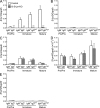S1P1 receptor directs the release of immature B cells from bone marrow into blood
- PMID: 20404103
- PMCID: PMC2867276
- DOI: 10.1084/jem.20092210
S1P1 receptor directs the release of immature B cells from bone marrow into blood
Abstract
S1P1 receptor expression is required for the egress of newly formed T cells from the thymus and exit of mature T and B cells from secondary lymphoid organs. In this study, we deleted the expression of the S1P1 receptor gene (S1pr1) in developing B cells in the bone marrow. Although B cell maturation within the bone marrow was largely normal in the B cell-specific S1pr1 knockout (B-S1pr1KO) mice, their newly generated immature B cells appeared in the blood at abnormally low numbers as compared with control mice. In the bone marrow of B-S1pr1KO mice, immature B cells in contact with the vascular compartment displayed increased apoptosis as compared with control mice. Forced expression of CD69, a negative regulator of S1P1 receptor expression, in developing bone marrow B cells also reduced the number of immature B cells in the blood. Attenuation of CXCR4 signaling, which is required for the proper retention of developing B cells in bone marrow, did not release immature B cells into the blood of B-S1pr1KO mice as effectively as in control mice. Our results indicate that the S1P1 receptor provides a signal necessary for the efficient transfer of newly generated immature B cells from the bone marrow to the blood.
Figures







References
Publication types
MeSH terms
Substances
Grants and funding
LinkOut - more resources
Full Text Sources
Molecular Biology Databases

